-
News & Trends -
Sales -
Marketing Related Topics -
B2B Software Guides Related Topics -
Free Tools & Resources -
- About Us About Us


A LinkedIn summary is the About section, aka bio, of a LinkedIn profile where salespeople generally position themselves as experts in their space while also explaining how their product or service provides great value for their customers. A well-written summary can help you improve lead generation and sell your product or service. Here we’ll share some of the best LinkedIn summaries from real salespeople and business owners and some tips for writing your own.
There’s so much to do when creating a LinkedIn profile optimized for lead generation. So we created a free LinkedIn optimization checklist that instructs you on how to fill out each part of your LinkedIn profile, from your summary to the Education section. Click the button below to download it and transform your profile into a lead-generating machine, then read on for the summary examples.
Use your LinkedIn summary to answer the questions leads likely have when they visit your profile. Some common ones are what you do for prospective buyers, what value your products or services offer, who your common customers are, and how to get in touch. And create all-caps headings to distinguish each answer and help leads navigate the summary. With clear information about your services, leads are more likely to reach out to you for help.
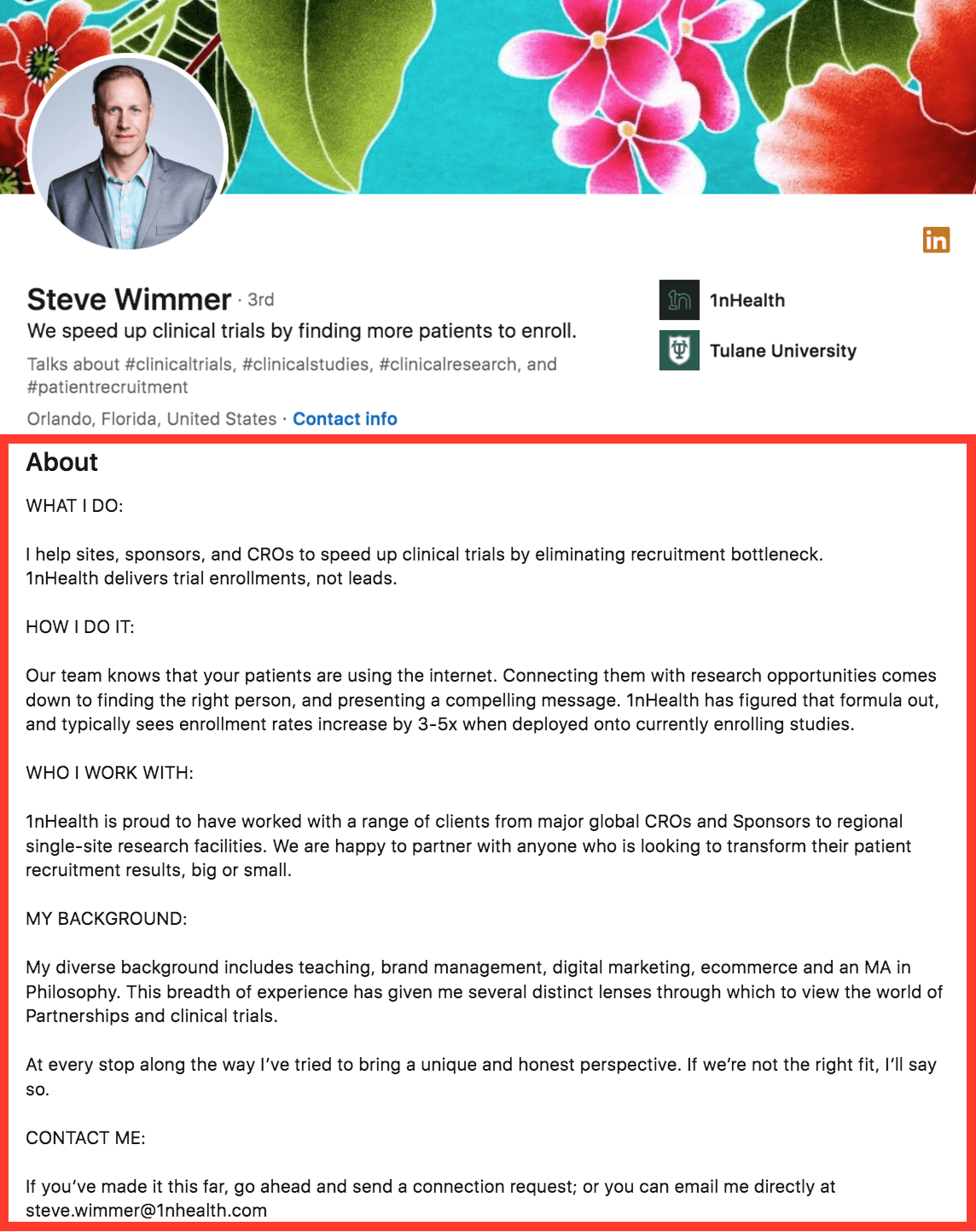
When asked about what makes his summary so successful, Steve Wimmer said, “It’s effective because it answers questions about me AND our company in an easy-to-consume way, and gives people a next step if they want to take it.” We especially like how he provides his background and says he’ll tell leads if the relationship is not a good fit. This makes him come across as personable, professional, and honest.
Salespeople and business owners should establish their credibility as an expert in their space, often within the very first paragraph of their LinkedIn summary. Leads want to talk with someone that they trust is going to be able to solve their problem and give them advice they wouldn’t have thought of themselves. To establish credibility, include credentials, accomplishments, years in the industry, books or articles you’ve written on the topic, and/or other expertise indicators.
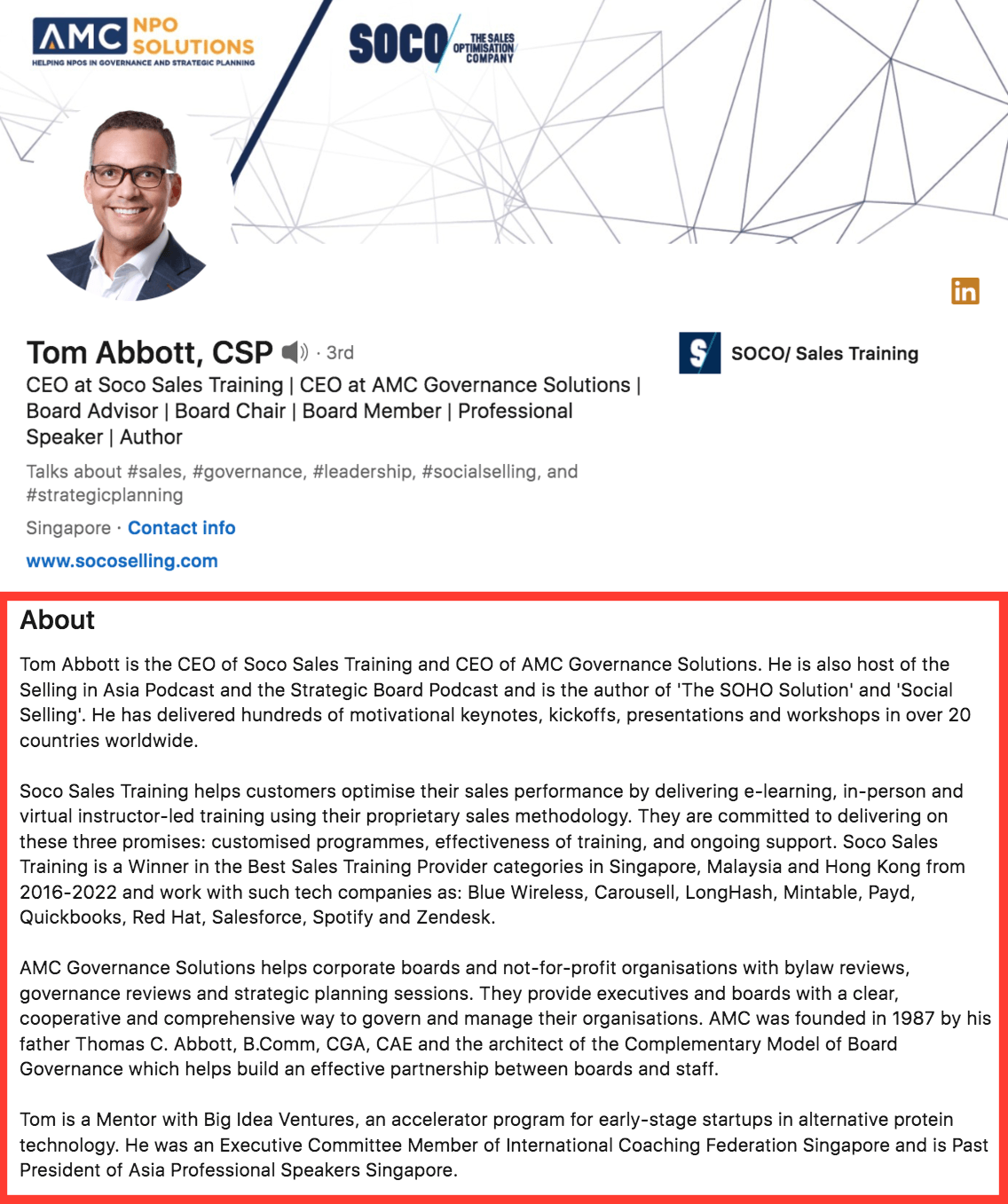
Tom Abbott proves his expertise by mentioning that he’s an author and that he’s done numerous keynote speeches and workshops. Plus, the third-person POV creates an authoritative feel. Anyone looking for a sales trainer would immediately think of him as a valuable resource. When asked about why it works, Tom said, “My profile summary is effective because it establishes my credibility and specifically describes who I help, what we help with, and how it benefits them.”
Sometimes keeping your profile summary short and using it to clearly highlight your company’s value proposition is the way to go. A value proposition is 1-2 sentences describing what value your products and services do for your clients. This is a great technique to use if you expect your leads to check out your LinkedIn profile to learn more about your business. By including the right keywords, you can also attract people searching on LinkedIn for services you sell.
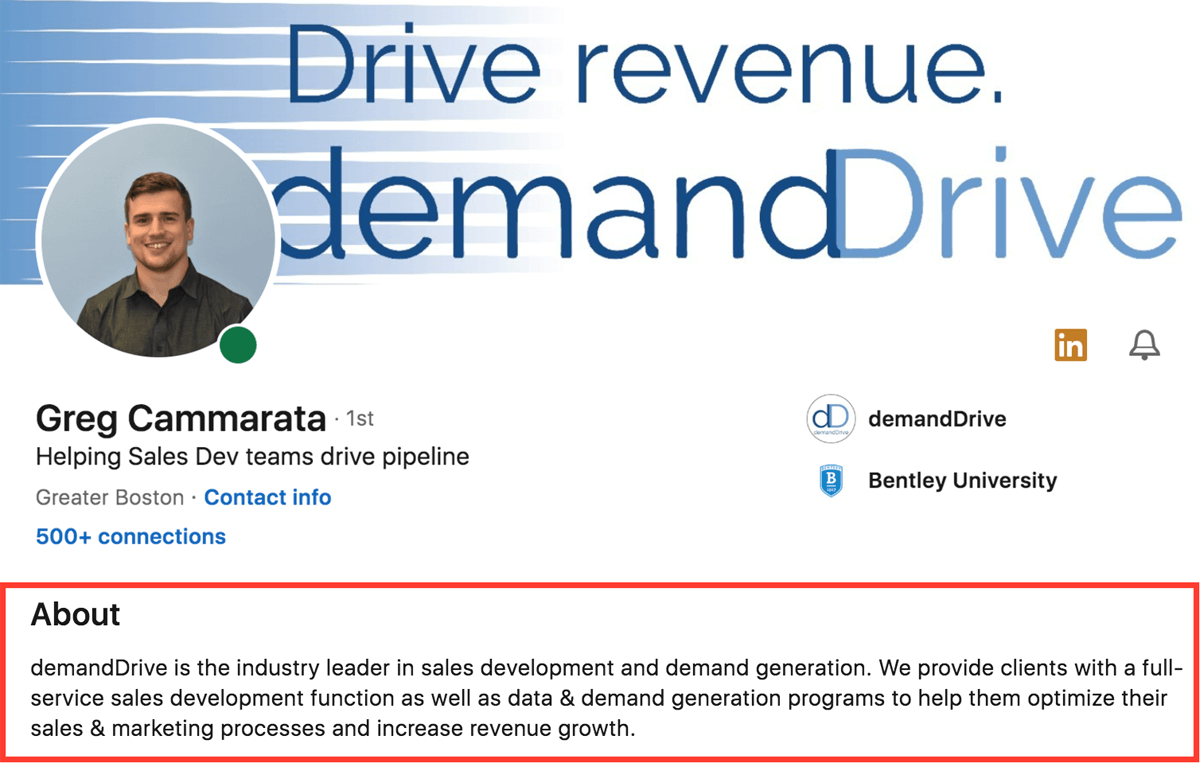
Greg Cammarata doesn’t add much flair, but that’s okay because his profile summary is acting as a simple reference point for leads and prospects he’s currently courting. They might check it out after he cold emails them, then they can quickly gauge the business he’s pitching. If they find the description relevant, they’ll likely respond. For this reason, he starts his summary with a general overview of demandDrive and then goes over what the company does and how it benefits clients.
If you’re trying to capture leads and start them on their customer journey, use your LinkedIn profile summary partly as a funnel to other educational content or websites that can help them learn more about your business. Somewhere within the summary, Include some links to your company’s product pages, blogs, or demo recordings. Usually, salespeople put them at the end as CTAs in hopes that leads who vibe with the summary’s overall message will follow them.
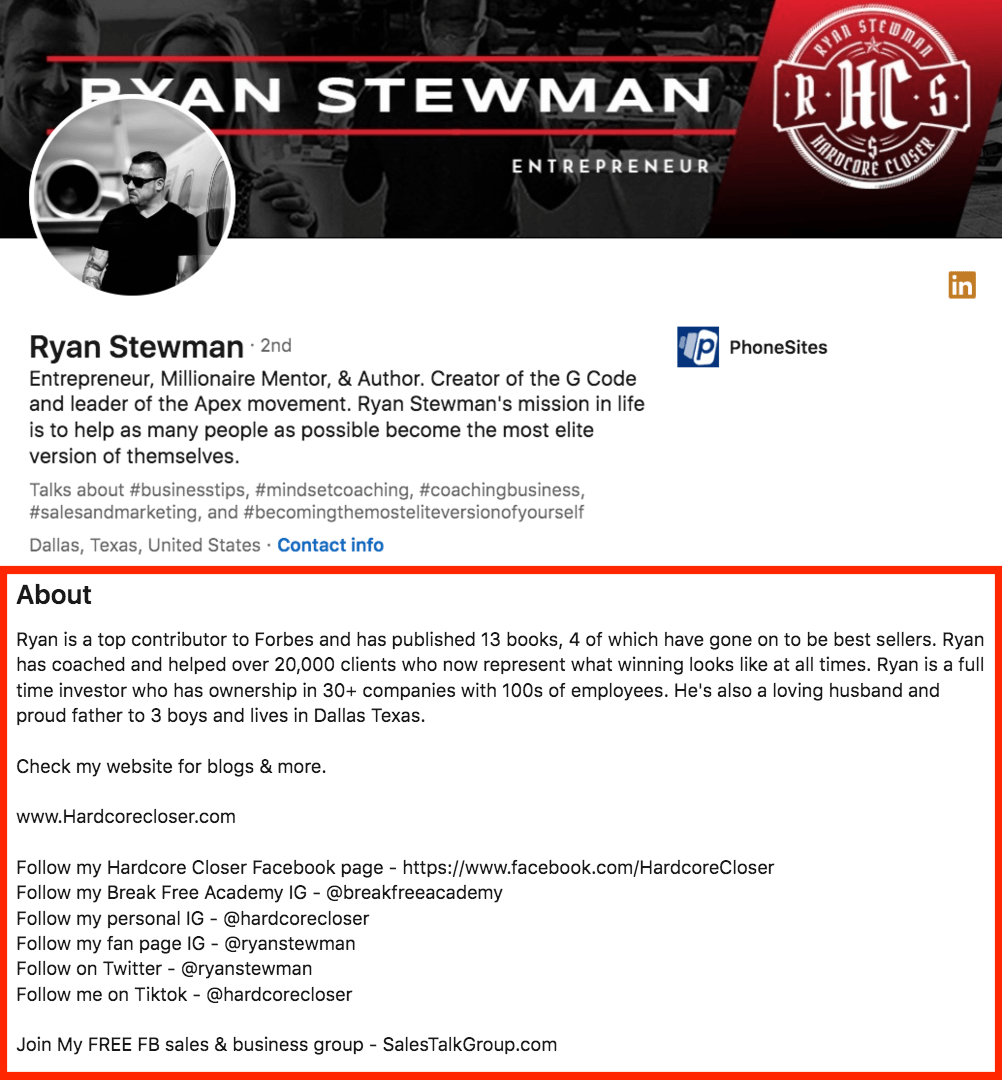
When we asked Ryan Stewman why his profile is so effective, he said, “My Linkedin About section is set up to where whoever comes to my page knows exactly what I do and who I've done it for, and extends the offer for me to help them as well. I also include links to all of my different social media accounts as well as my website to ensure I've made it as easy as possible for potential clients to get in contact with me.” This tactic helps him find and educate sales leads.
As a salesperson, it's generally a good idea to keep your LinkedIn summary short and to the point, especially if you’re using the section to hook leads. Often, the most important information you want them to gain from a visit to your profile is an idea of how you can help them succeed. This strategy does this in one sentence, ensuring almost every visitor reads the whole summary and walks away with knowledge about how this sales rep can assist them.
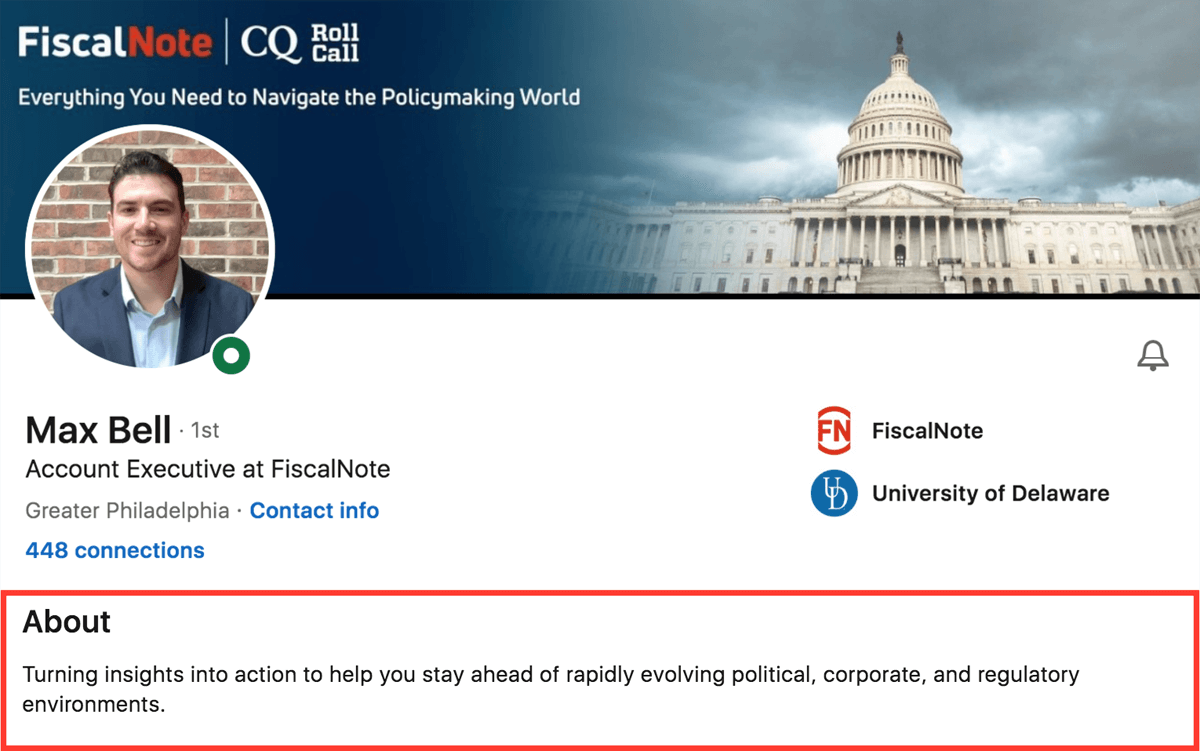
Max Bell does a good job here of briefly explaining how he, the account executive, can help potential customers. However, by saying “turning” instead of “I turn,” the section takes on a useful double meaning. Leads who read this will likely walk away feeling that he, and the solution he sells, will both help them accomplish their goals. Because it’s so short, the profile implicitly encourages visitors to go check out his company’s website to learn more.
At its core, sales is all about finding people with a need you can satisfy, and convincing them that you’re the best person or business to do it. Therefore, it makes sense to start your LinkedIn summary off with a sentence explaining who you help and how you do it. This enables leads who come to your profile to self-qualify. They immediately know if they fit your target customer, and get a sense of the benefits of working with you or buying your product or service.
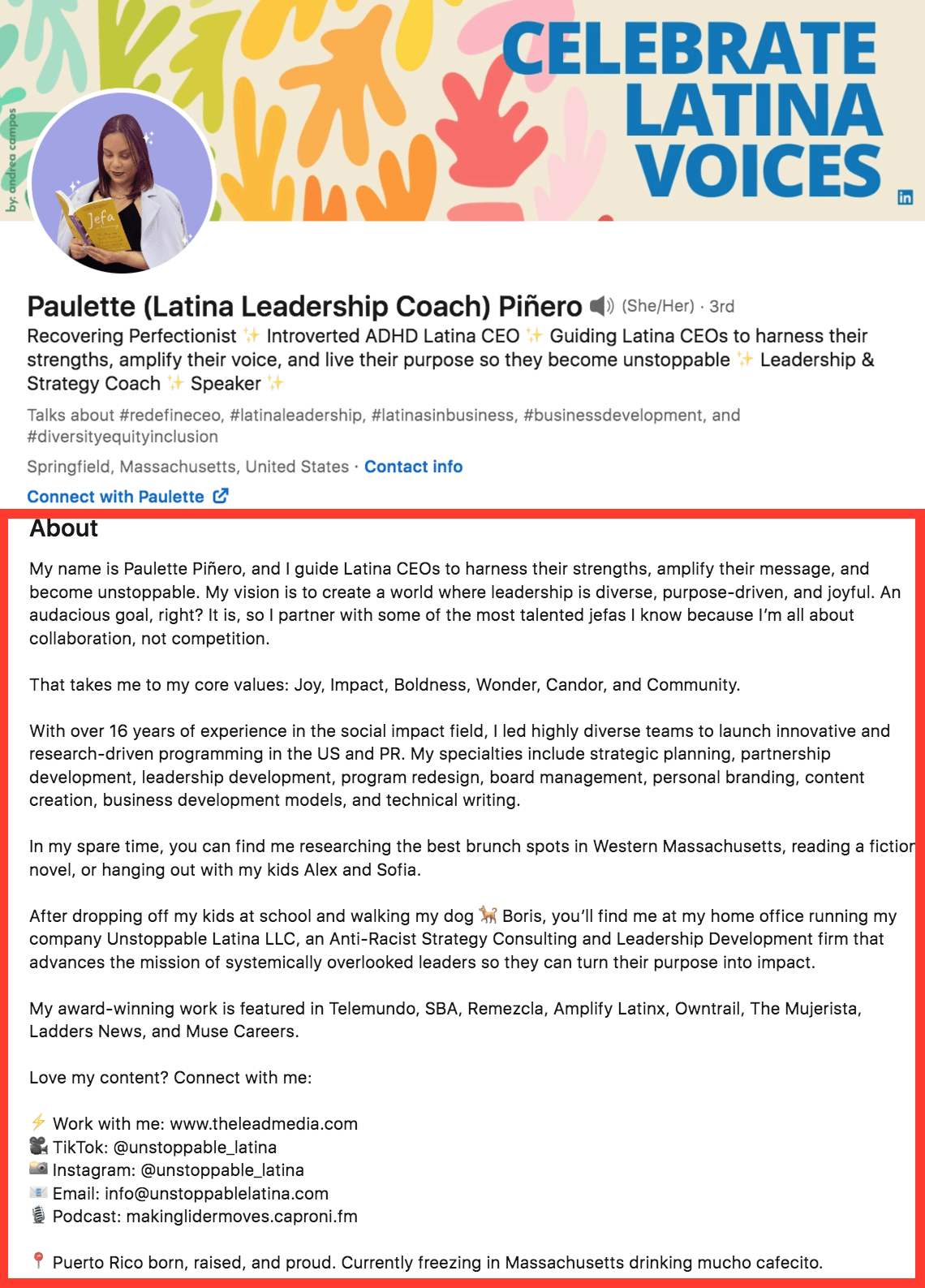
In the first sentence, Paulette Piñero makes two important details about her leadership coaching business very clear to her profile visitors: who she helps (Latina CEOs) and what she does for them (makes them unstoppable). This should hook any Latina CEO looking for coaching services. For the rest of her summary she mentions her mission, establishes her expertise, gets personal — thus relatable — and lastly gives potential leads different ways to connect with her.
When you make a cold call, one of the first things you should do is mention a pain point that’s relevant to your target customer. Hitting a nerve is often your best bet for hooking a potential lead. You can use the same approach in your LinkedIn summary. State one thing that drives your customers mad and use the rest of the summary to explain your solution. For example, a rep selling to sales managers might write, “Can’t get your reps to update their CRM?”
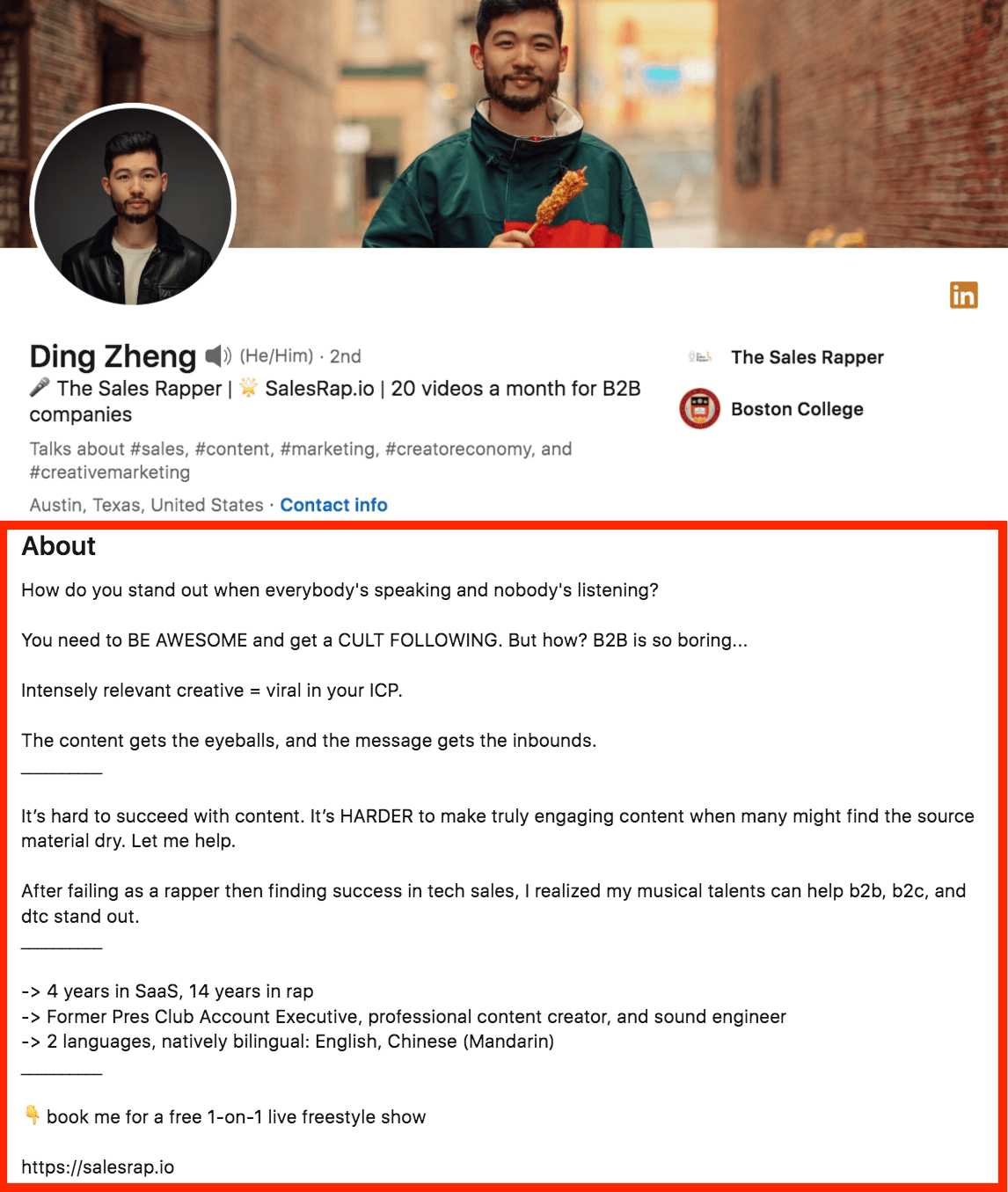
Ding Zheng, a small business owner, executes the pain point strategy well. He begins his profile summary by stating a common pain point for B2B content marketers: standing out from the crowd. Next, he tells them how to solve it, positioning his sales rapping as the creative solution. Lastly, he hints at his skills and confidence with a fun and daring CTA that encourages potential leads to book time with him for a one-on-one live freestyle.
Bullet points are a great way to make your LinkedIn summary easier to read for your leads. When faced with a wall of text, busy readers might become discouraged and bounce off your page. To avoid this, whenever you have three or more things you want to list, such as your business’s services, products, or benefits, consider putting them into a bulleted list.
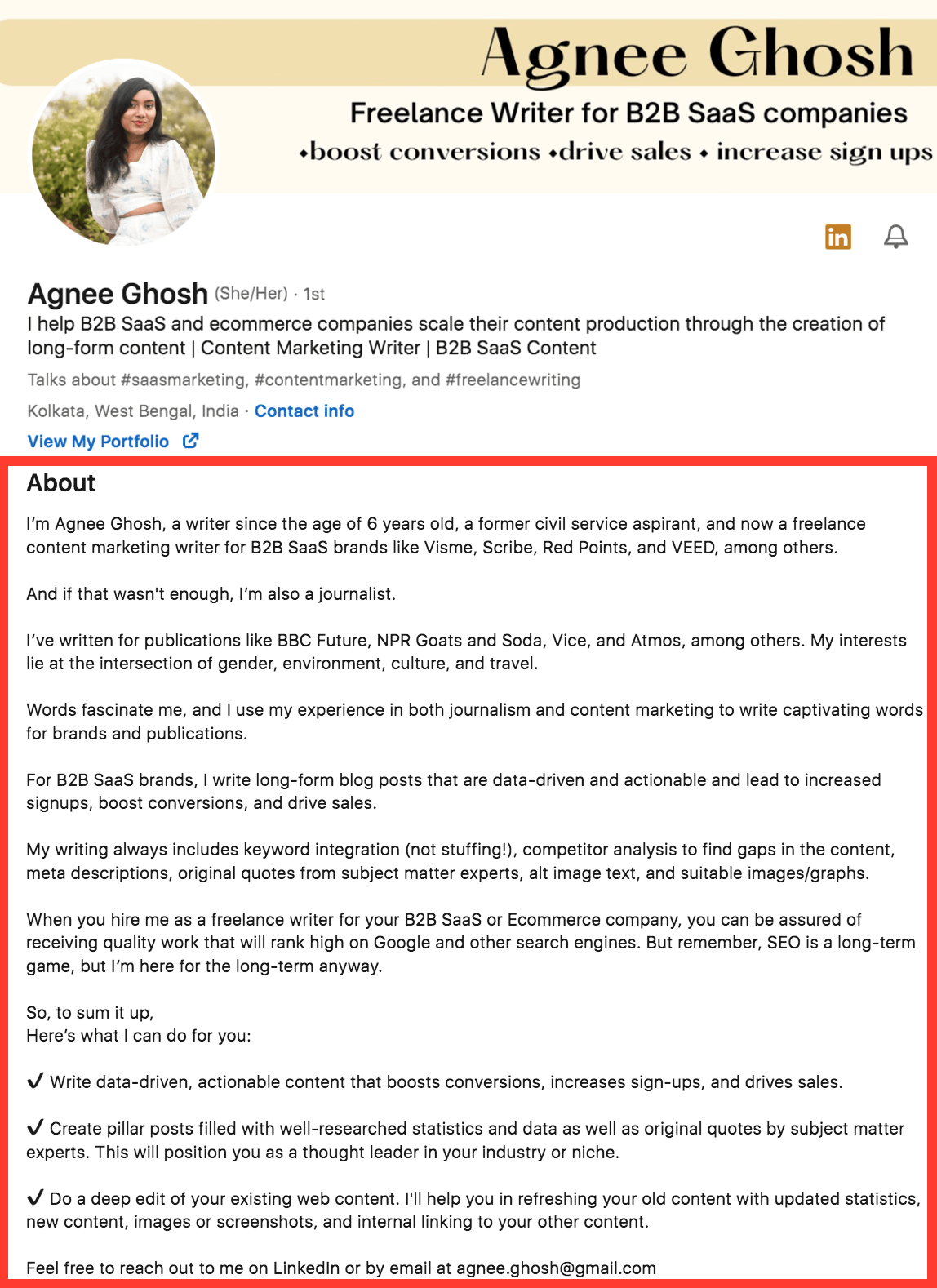
Agnee Ghosh, a freelance writer, and therefore a seller of her services, begins by successfully persuading her leads that she’s an experienced B2B writer. She lists well-known brands she’s written for, talks about her love for words, and discusses her approach. Her abilities established, she then transitions into talking about the services she can provide for her customers, and organizes them into three bullet points, making them digestible and clear to the reader.
Your potential buyers are likely also looking at other vendors, so it’s vital to your success that you clearly articulate your company’s key differentiator or unique selling proposition. In your LinkedIn profile summary, let visitors know exactly how you differ from the competition. What do you do best? Why is your approach more effective? What do you offer that they don’t? These are just some questions to get you thinking about how to stand out.
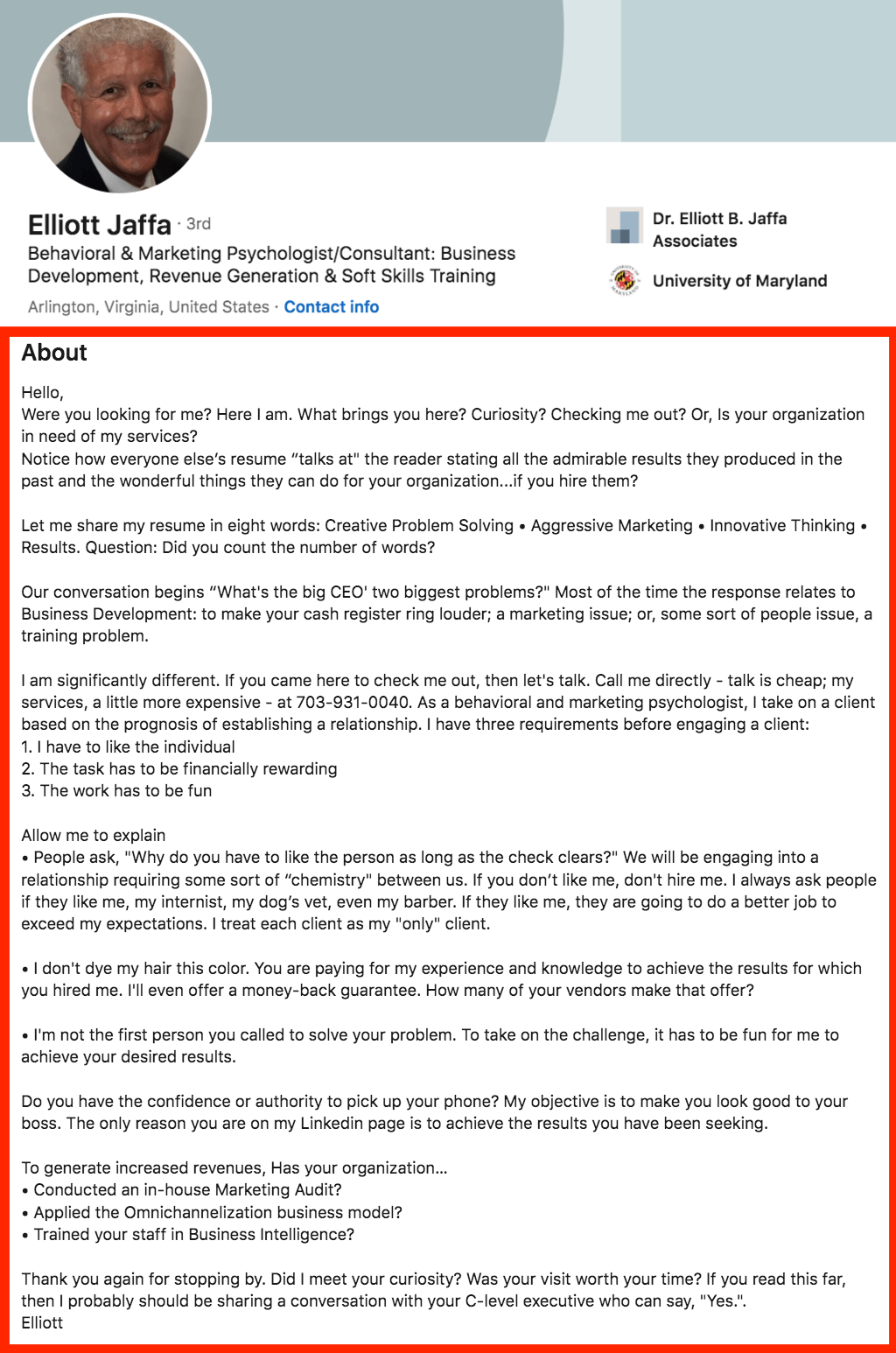
Reading Elliot Jaffa’s summary, you’ll notice right away that he’s funny and has a distinct voice. This immediately separates him from the robotic LinkedIn summaries out there. Second, he explains how his service is different from other marketing psychologists in that he only takes on customers he knows he’ll connect with on a personal level. Plus, unlike others, he offers a money-back guarantee. It’s a long summary, but it still works because of his engaging writing.
If you’re promoting your own B2B business, it’s often a smart move to name-drop some of your most recognizable clients somewhere in your LinkedIn summary. This tactic builds your credibility and makes leads curious about working with you. Listing the company names vertically is a good way to make your clientele pop in your summary.
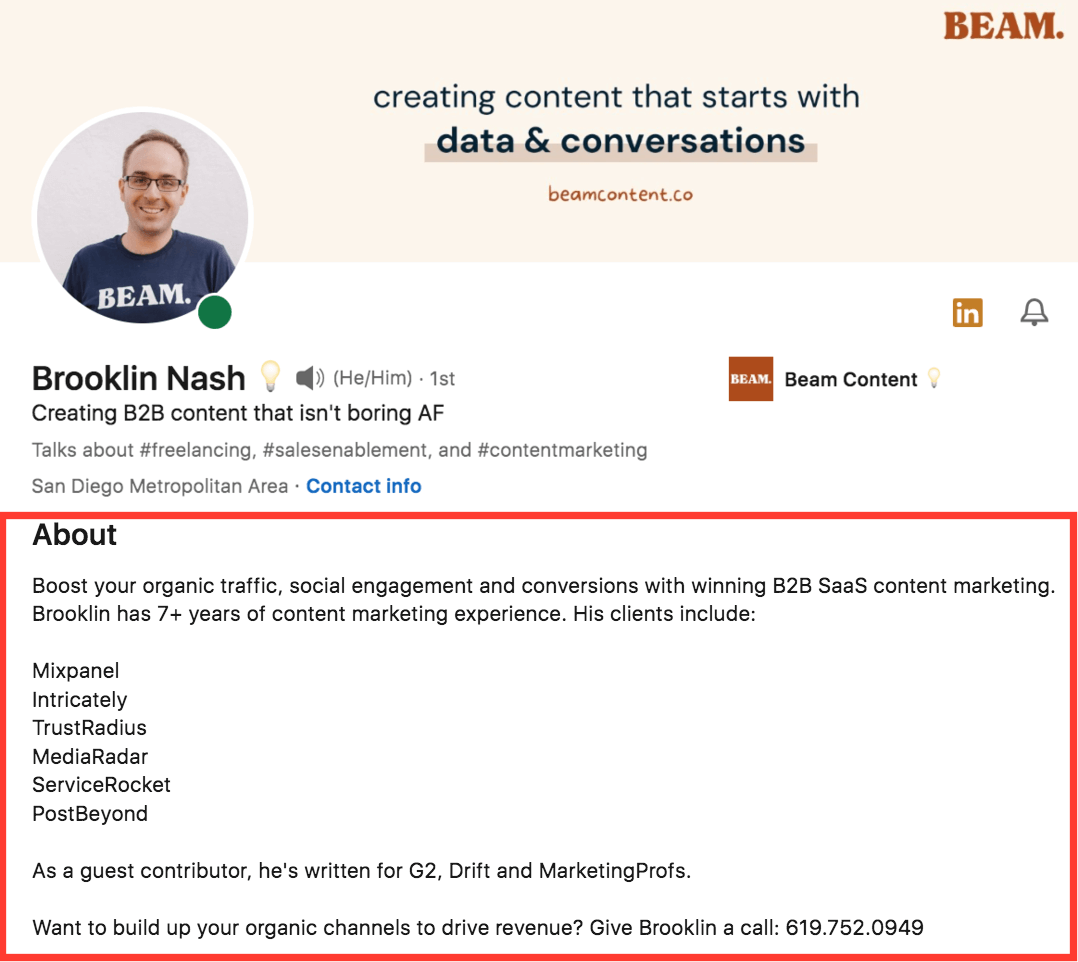
Brooklin Nash starts his summary off with the benefits his content marketing agency regularly provides its clients. This hooks potential customers and makes them want to learn more. Next, he lists some well-known companies his business has helped, thereby establishing some credibility. Lastly, he ends with a CTA that encourages leads to give him a call. Overall, this is a great profile summary for generating leads for a business.
Here’s a helpful trick: While writing your LinkedIn summary, pretend that you’re talking with your ideal customer at a bar or a cafe. Keep your phrasing simple. Avoid big words you’d never use in real speech. By doing this, your profile summary will do a better job of captivating and holding the reader’s attention. Some other techniques for conversational style are shorter sentences, the use of the second and first person, and a friendly, relatable voice.
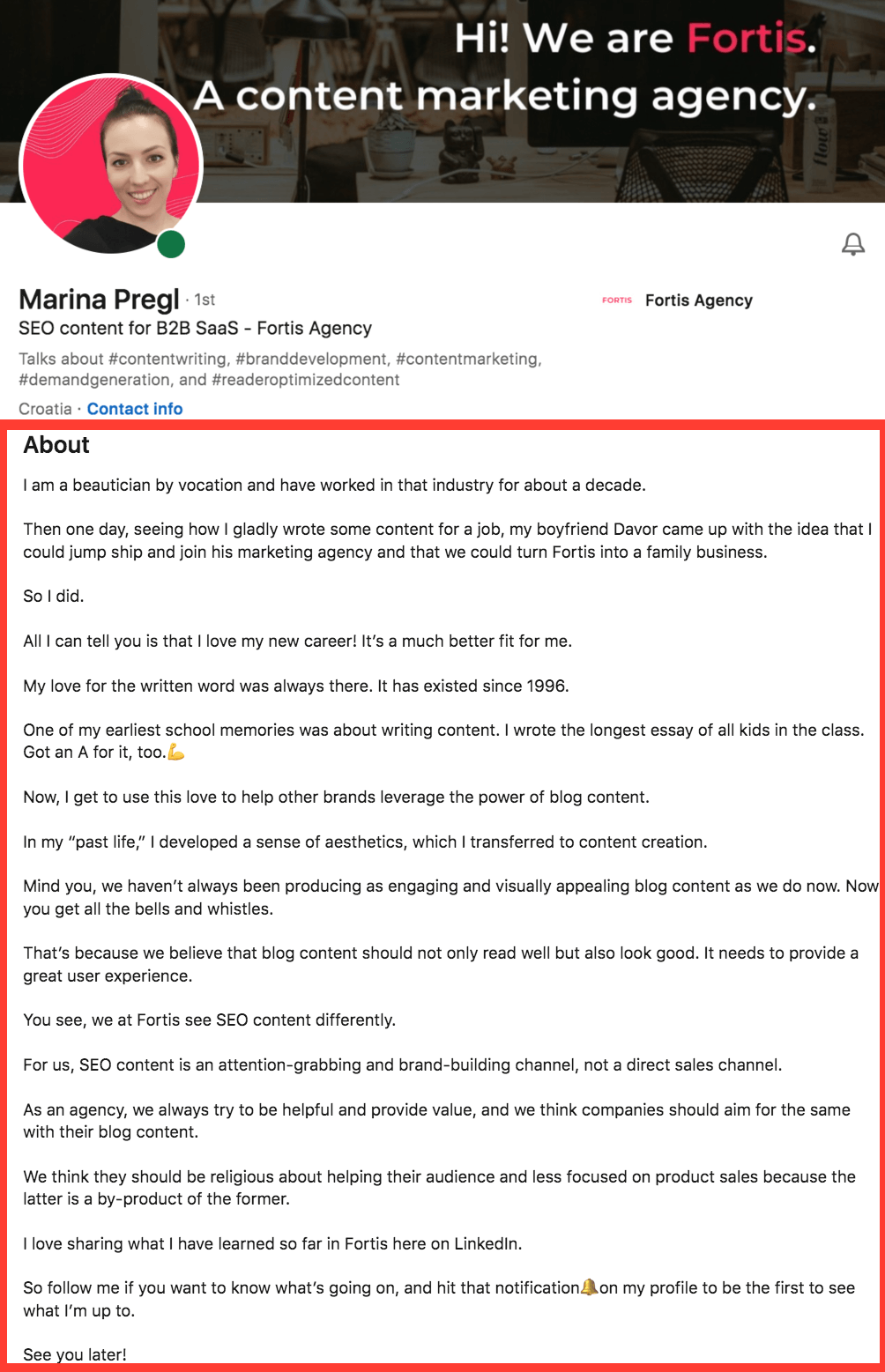
Marina Pregl excellently uses a conversational tone and storytelling tactics to position both herself and her business as relatable, unique, and experienced. She uses short paragraphs, exclamation points, and a positive and honest voice. She even includes emojis, which are good at evoking emotions in a reader. At the end, Marina includes a CTA asking people to follow her profile. Gaining followers on LinkedIn is a great way to build credibility and find leads.
Some customers want a one-stop-shop — a business that will handle all types of work involved in a similar class. For example, a client might want to work with a freelance content writer who can write blog posts, ebooks, case studies, and anything else they need. That way, they don’t have to form and maintain multiple relationships. So, if you’re trying to attract those clients, make sure to clearly list all of the services you can provide in your LinkedIn summary.
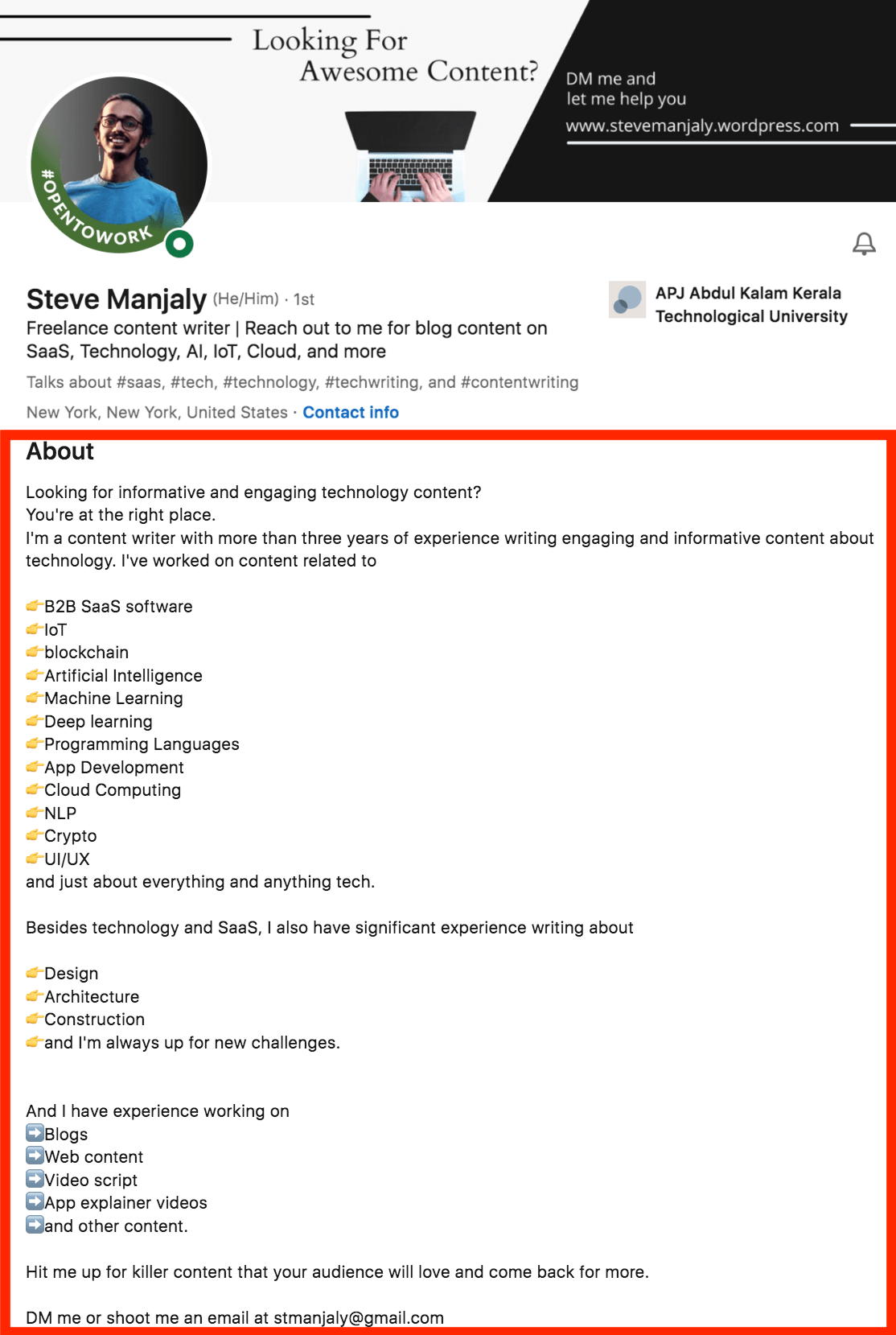
Steven Manjaly, a freelance writer, uses his summary mainly to show his leads what services he can offer them. By listing multiple sub-niches within the technology industry, he shows his range in terms of topics he can write authoritatively about. Plus, by listing different types of content he can write, he comes across as a one-stop-shop for a tech company’s content needs, something certain customers love. He ends his summary with two ways to reach out to him for content help.
Customers want to work with someone who has a lot of experience in their industry because it’s likely that person can provide them with insights and advice they couldn’t discover on their own. This is especially true for companies hiring consultants. So, if you have a boatload of experience, call it out in your summary to secure credibility for yourself and your business.

Joe Benjamin, the founder of RevPilots, is a consultant for startups trying to increase sales, and he does a great job of proving his expertise early in his summary. First, he explains how he spent the last 10 years working at startups in sales leadership positions and founded his own company. This hooks startup founders and makes them trust him. Then he states his offer and tells readers who he’s trying to help. His pressure-free CTA encourages founders to reach out.
One of the best ways to establish yourself as an authority in your space is to write thought pieces about your industry and get them published in well-known publications. If you’ve successfully done this, share the names of the publications in your LinkedIn summary. For example, a financial advisor whose work is published in the The Wall Street Journal should definitely show this off to potential leads reviewing his profile.
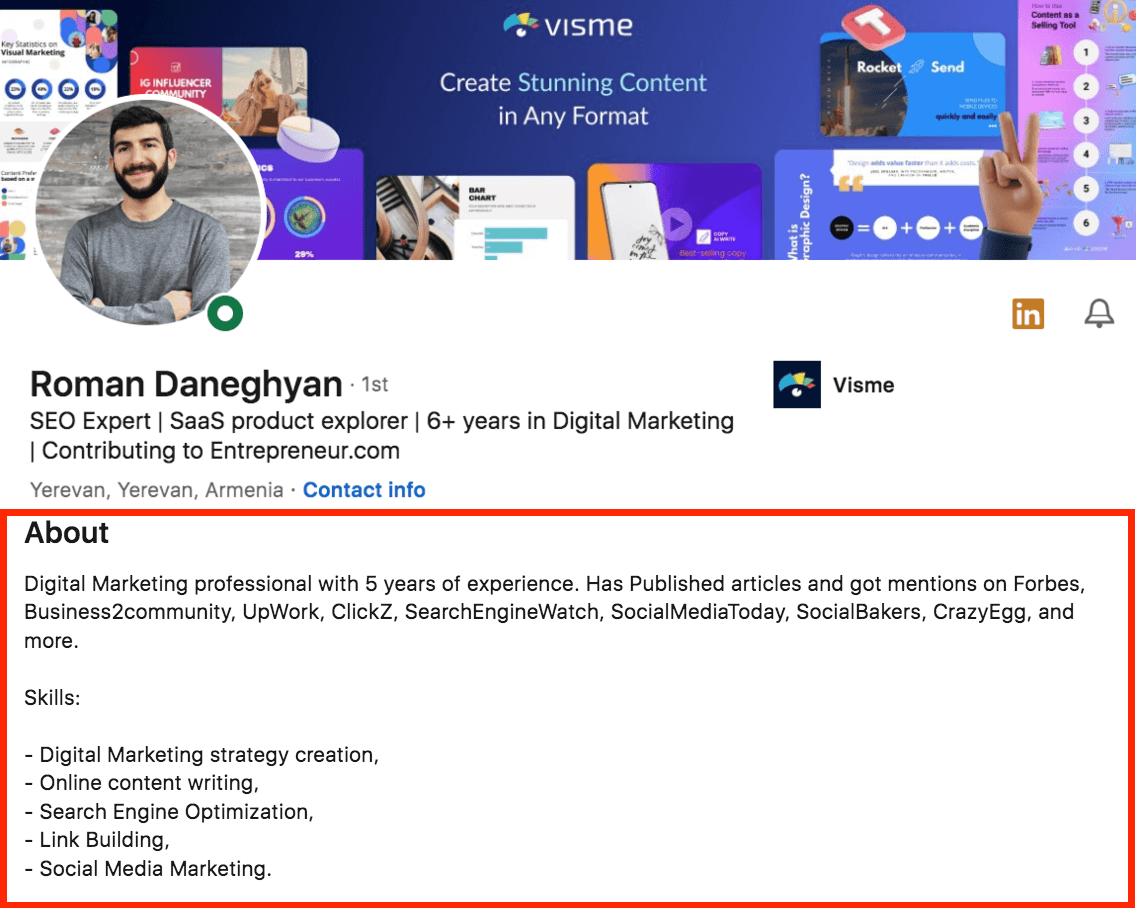
Roman Daneghyan starts by writing his years of experience as a digital marketer and then lists some recognizable marketing publications where he’s been published, hence establishing himself as an expert to visitors. Next, he goes into the exact skills he specializes in so that leads know exactly what he’s capable of doing for them. A major thing that’s missing is a CTA, but that could be because his schedule’s too jam-packed right now to accept new business.
It’s often not enough to just say you’re an expert in your industry or field. To really persuade your potential leads of your insider knowledge, you have to back up your claims with some anecdotes or facts. For example, if a real estate salesperson claimed to be an exceptional agent in their summary, they should prove it with some statistics, a client success story, or some sort of evidence. Following this best practice will help you convince more leads to reach out to you.
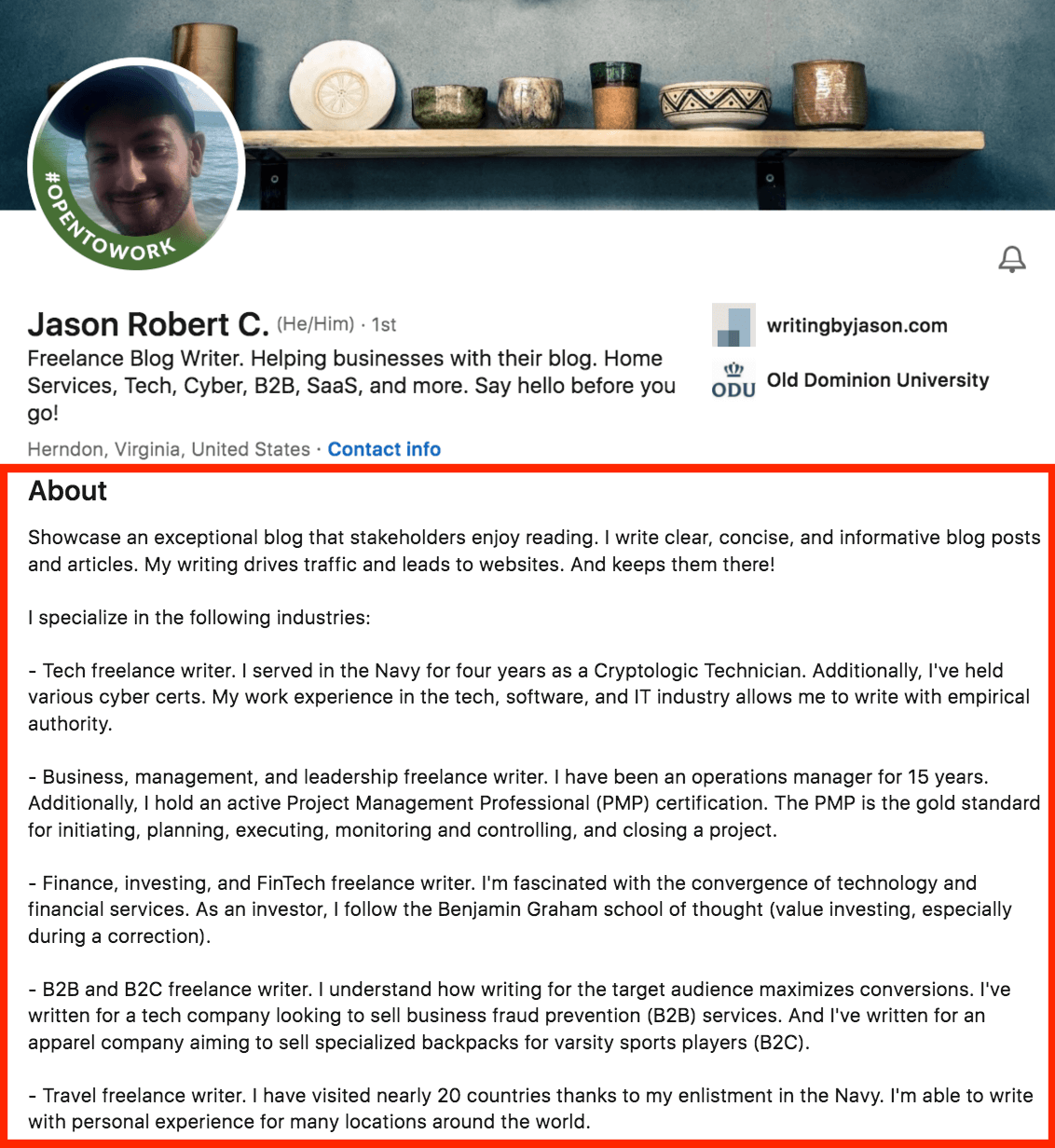
Jason Robert, owner of Writing By Jason, can write authoritatively in five different industries for his customers, something he proves in his summary. After opening with a value proposition, he names the five industries, and beside each one, writes a few sentences, rich in personal anecdotes, suggesting his expertise. For example, he says he can write about management, and supports this claim with the fact that he’s been an operations manager for 15 years.
Your leads might have had bad experiences with companies similar to your own, so they might carry some hesitations when evaluating your brand. If you know some worries your customers commonly have, perhaps that they mention in sales calls, bring them up in your LinkedIn summary. Then explain how you’re different from other companies in your industry and why your customer shouldn’t be worried. By doing this you set your potential leads at ease.
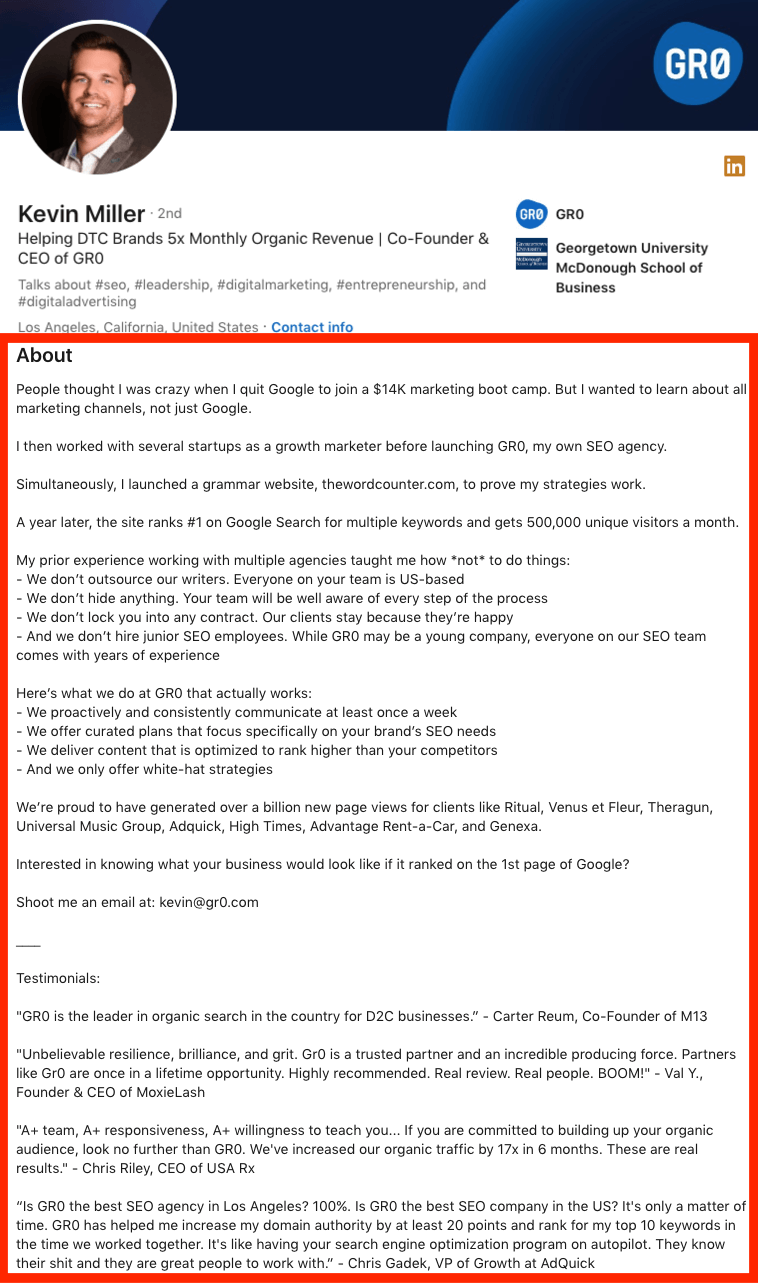
Kevin Miller’s summary might be the best summary on this list. He starts by proving his credibility and hooking the reader with a summary of one of his biggest accomplishments. Next, he lists five ways that he’s different from competitors, thereby heading off any of the visitor’s objections about working with an SEO agency. Then he describes his team’s approach, name-drops some clients, and makes a CTA. To top it all off, he shares four customer testimonials.
If you’re using your LinkedIn profile to sell your business to potential customers, an effective LinkedIn summary can help you attract high-quality visitors and convert them into promising leads. Writing an effective LinkedIn profile summary is easiest when you have role models you can use as inspiration. So spend some time figuring out what elements you love most about the above lead-generating summaries and then integrate them into your own. Semi-imitation is a great way to learn.


Sam is a former SaaS sales rep turned freelance writer. He spent his career selling real estate technology to C-suite executives before switching over to blogging, where he now covers sales, marketing, and small business topics. Sam specializes in lead generation, lead nurturing, and deal closing articles for Selling Signals. When he’s not researching the latest sales trends, he’s either penning short stories, hiking, or reading in NYC’s Washington Square Park.

Selling Signals delivers actionable advice for sales and marketing professionals. Learn strategies that help you hit targets, strengthen customer relationships, and win more business. Get expert advice on lead generation, sales processes, CRM software, sales management, and account management directly to your inbox.
Property of TechnologyAdvice. © 2025 TechnologyAdvice. All Rights Reserved
Advertiser Disclosure: Some of the products that appear on this site are from companies from which TechnologyAdvice receives compensation. This compensation may impact how and where products appear on this site including, for example, the order in which they appear. TechnologyAdvice does not include all companies or all types of products available in the marketplace.